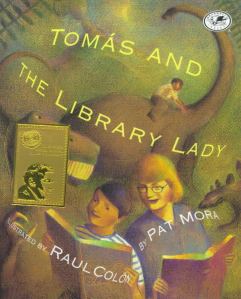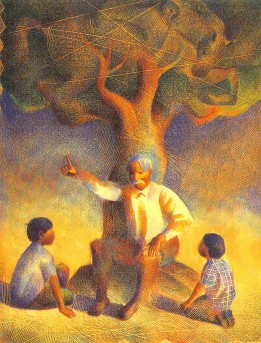 Saludos todos! Our book for this week is Tomás and the Library Lady, written by Pat Mora and illustrated by Raúl Colón. Although last week we focused on Pura Belpré, the first Puerto Rican librarian at the New York City Public Library, this week we are focusing on the legacy of Tomás Rivera, another symbol of Latin American literature and Hispanic-American heritage. Like Belpré, Rivera loved literature and pioneered outreach projects to the Hispanic-American community. As an author, poet and professor, he was beloved for his enthusiasm and his passion for teaching, learning, and books. While we continue to celebrate Hispanic Heritage Month and the many sensational figures associated with that legacy, we are turning our attention this week to another exceptional figure.
Saludos todos! Our book for this week is Tomás and the Library Lady, written by Pat Mora and illustrated by Raúl Colón. Although last week we focused on Pura Belpré, the first Puerto Rican librarian at the New York City Public Library, this week we are focusing on the legacy of Tomás Rivera, another symbol of Latin American literature and Hispanic-American heritage. Like Belpré, Rivera loved literature and pioneered outreach projects to the Hispanic-American community. As an author, poet and professor, he was beloved for his enthusiasm and his passion for teaching, learning, and books. While we continue to celebrate Hispanic Heritage Month and the many sensational figures associated with that legacy, we are turning our attention this week to another exceptional figure.
Some of you may recognize Tomás Rivera’s name from one of my earlier posts featuring the 2016 Tomás Rivera Award recipients. The award, which is bestowed in memory of Rivera and his love for literature, honors exceptional Latinx children’s and young adult books. In line with many of the values now symbolized by Rivera’s legacy, this story shows the intercultural and intergenerational power of literature, as well as the timeless beauty of a shared culture.
Many of you may also recognize this book’s author and illustrator, since both Mora and Colón have been featured many times on our blog. In Tomás and the Library Lady, the talents of both Mora and Colón fuse together to create a rich and heart-warming tale about comfort, companionship, and the unrelenting power of imagination.
 Mora offers a summary of Rivera’s background in a “A Note About the Story” at the back of the book:
Mora offers a summary of Rivera’s background in a “A Note About the Story” at the back of the book:
Tomás Rivera was born in Crystal City, Texas, in 1935. A migrant worker who valued education, Tomás Rivera became a writer, a professor, a university administrator, and a national education leader. When Dr. Rivera died in 1984, he was the chancellor of the University of California at Riverside. The campus library now bears the name of the boy who was encouraged to read by a librarian in Iowa.
The story begins with a young Tomás sitting in a car on the family’s journey from their Texas home to Iowa for the summer. His parents are farm workers and they spend their summers picking fruit and vegetables in Iowa. For readers who come from migrant farm worker families, this narrative may be all too familiar.
While his parents work, Tomás keeps busy by playing with a ball that his mother sewed from an old teddy bear, and listening to his grandfather tell stories. He knows all of his grandfather’s tales by heart: “Papa Grande laughed. ‘Tomás, you know all my stories,’ he said. ‘There are many more in the library. You are big enough to go by yourself. Then you can teach us new stories.’”
 The next day Tomás goes to the public library and is greeted by a friendly librarian who instantly offers him a glass of water, reminding readers of Tomás’ initial car ride, when he was acutely aware of his thirst while driving through the hot and dusty farmlands of the Midwest: “‘if I had a glass of cold water, I would drink it in large gulps. I would suck the ice. I would pour the last drops of water on my face.’” Tomás’ physical thirst for water parallels his metaphorical thirst for knowledge. At the library, Tomás slakes both needs: he enjoys a reprieve from the abrasive heat while also escaping into the world of dinosaurs and wild cowboys.
The next day Tomás goes to the public library and is greeted by a friendly librarian who instantly offers him a glass of water, reminding readers of Tomás’ initial car ride, when he was acutely aware of his thirst while driving through the hot and dusty farmlands of the Midwest: “‘if I had a glass of cold water, I would drink it in large gulps. I would suck the ice. I would pour the last drops of water on my face.’” Tomás’ physical thirst for water parallels his metaphorical thirst for knowledge. At the library, Tomás slakes both needs: he enjoys a reprieve from the abrasive heat while also escaping into the world of dinosaurs and wild cowboys.
Tomás spends his days soaking up these stories, and in the evening shares them with his family (Mama, Papa, Papa Grande and his brother, Enrique). This includes translating what he read in English into Spanish, so that his family can understand. Back at the library, Tomás also begins teaching the library lady how to say some words in Spanish: “He liked being the teacher.” This description give readers a preview of the kind of person Tomás Rivera will eventually become—distinguished scholar, lover of literature, intercultural ambassador, and beloved teacher. It also illustrates the power of literature and story-telling in bridging different communities.
 At the end of the book, Tomás’ grandfather, Papa Grande, comes to the library and meets the wonderful library lady. Two important figures in Tomás’ life, both from an older generation, yet from vastly different communities and backgrounds, meet and shake hands in the library: “‘Buenas tardes, señor.’ Tomás smiled. He had taught the library lady how to say ‘Good afternoon, sir’ in Spanish.” Readers will be delighted and inspired in seeing how little Tomás brings people together from different backgrounds through the wonderful, eye-opening power of teaching, learning, and literature.
At the end of the book, Tomás’ grandfather, Papa Grande, comes to the library and meets the wonderful library lady. Two important figures in Tomás’ life, both from an older generation, yet from vastly different communities and backgrounds, meet and shake hands in the library: “‘Buenas tardes, señor.’ Tomás smiled. He had taught the library lady how to say ‘Good afternoon, sir’ in Spanish.” Readers will be delighted and inspired in seeing how little Tomás brings people together from different backgrounds through the wonderful, eye-opening power of teaching, learning, and literature.
Both the setting and Tomás’ enthusiasm are captured and reinforced by Colón’s beautiful illustrations. According to a review from Goodreads, “Colón’s beautiful scratchboard illustrations, in his textured, glowingly colored, rhythmic style, capture the warmth and the dreams that the boy finds in the world of books.” Indeed, the soft, sepia-toned illustrations evoke both the steamy daze of the Midwest summer heat and the dreamy solace found in the library’s books and stories.
For those of you interested in using this book in the classroom, here are some additional materials:
- Harvard Family Research Project Teacher Guide for Tomás and the Library Lady
- Achieve the Core lesson plan
- First Stage Enrichment Guide
- Lesson Plan from Pat Mora’s personal website
- Random House Teacher’s Guide
For more information about the author and illustrator, check out these additional links:
- In-depth written interview with Pat Mora
- In-depth written interview with Raul Colon
- Pat Mora personal website
- Pat Mora blog
If you are interested in more works by Pat Mora and Raúl Colón, check out these links to some of my book reviews from last year:
- ¡Mira Look! Book review of Doña Flor: A Tall Tale About a Giant Woman with a Great Big Heart, written by Pat Mora and illustrated by Raul Colon
- ¡Mira, Look! Book review of ¡Yum, MmMm, Qué Rico!, written by Pat Mora
Stay tuned for more amazing books!
¡Hasta pronto!
Alice
Images modified from: Tomas and the Library Lady pages 5, 7, 15

Pingback: 10 Children’s and YA Books about Sung & Unsung Latin@ Heroes | Vamos a Leer